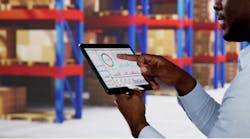IoT sensors, drones and virtual reality (VR) are key technologies revolutionizing warehouse layout optimization. Warehouse layout optimization is vital for improving operational efficiency and reducing costs as it streamlines workflows, maximizes space utilization and minimizes inefficiencies. By providing data insights and enabling predictive analysis, emerging technology empowers warehouse managers with actionable insights that allow for maximum productivity. Integrating VR, in particular, into warehouse operations resulted in time savings of 22% and a 33% reduction in errors in just two months, a recent BMW study found.
IoT Sensor Technologies
IoT sensors—tiny wireless sensors that collect data and transmit it to a central system—can monitor warehouse environmental conditions (such as temperature, humidity, motion and lighting) that impact the quality and integrity of stored goods, ultimately preventing damage or spoilage. For instance, if certain areas of the warehouse experience temperature variations due to proximity to doors, windows or HVAC vents, managers can then make informed decisions about layout adjustments, such as relocating sensitive inventory to more stable environments or reconfiguring shelving arrangements to optimize airflow and temperature distribution.
IoT sensors are typically easy to install and scalable for use in large warehouse environments. Before installing these sensors in your warehouse, determine which areas most require monitoring, such as storage zones for temperature-sensitive goods or high-traffic areas for motion detection. You’ll then need to select sensors appropriate for the specific environmental factors you need to monitor, whether they be temperature sensors for cold storage or humidity sensors for moisture-sensitive areas. Always remember to calibrate the sensors according to manufacturer specifications before installation to ensure accurate readings. Regularly recalibrate sensors as needed to maintain accuracy over time.
Warehouse Drones
Drones can revolutionize warehouse layout optimization by providing comprehensive data collection, analysis and real-time situational awareness, leading to more efficient and strategically designed warehouse layouts. Drones can track and analyze the movement of goods, equipment and personnel within the warehouse. By tracking the flow of traffic along different pathways, drones can then identify bottlenecks, chokepoints and areas of congestion that impede operational efficiency. This data can inform decisions about optimizing aisle widths, repositioning storage areas or implementing traffic management strategies to improve workflow and reduce delays.
Moreover, drones can also provide real-time situational awareness and assistance in the event of emergencies like fires, leaks or security breaches, therefore enhancing facility safety and security. Drones equipped with thermal imaging cameras can detect heat sources or temperature anomalies, aiding in fire detection and emergency response efforts. Additionally, drones can also help monitor evacuation routes, assess structural integrity and coordinate emergency personnel to ensure the safety of warehouse staff and assets.
When integrating drones into warehouse layout optimization, carefully select drones based on factors such as flight time, payload capacity and maneuverability to ensure they can effectively navigate warehouse environments and efficiently perform inventory tasks. Testing and calibration are also crucial to ensure accurate data capture and reliable performance. This involves subjecting drones to varied warehouse conditions, adjusting settings to optimize performance and accuracy while also considering factors like lighting, obstacles and signal strength.
Virtual Reality
VR—immersive technology that transports users to computer-generated environments, offering realistic experiences through VR headsets—allows warehouse managers to immerse themselves in a 3D virtual representation of the warehouse, experiment with various layout designs in real-time and assess the strengths and weaknesses of different configurations, including shelving arrangements, aisle widths and equipment placement. Material flow, order picking processes and equipment utilization can also be simulated to identify potential bottlenecks or inefficiencies. VR simulations can reveal congestion points in the layout where aisles are too narrow or storage areas are poorly organized, leading to delays in material handling. Strategic changes can then be implemented based on these insights (redesigning aisle widths or reconfiguring storage zones, for example).
Ideally, warehouse managers should select VR hardware specifically designed for warehouse environments, including durable headsets resistant to dust and impact, along with ergonomic controllers for extended use. This way, you’ll ensure reliability and comfort in challenging warehouse conditions. Hardware should also be compatible with existing warehouse software and technology (like inventory management systems) to ensure efficient data exchange and unified operations.
Warehouse layout optimization is crucial for boosting productivity, efficiency and safety in warehouse operations. IoT sensors, drones and VR are key emerging technologies that revolutionize this process by providing real-time data insights, enabling aerial surveillance and inventory management and facilitating immersive design simulations.








